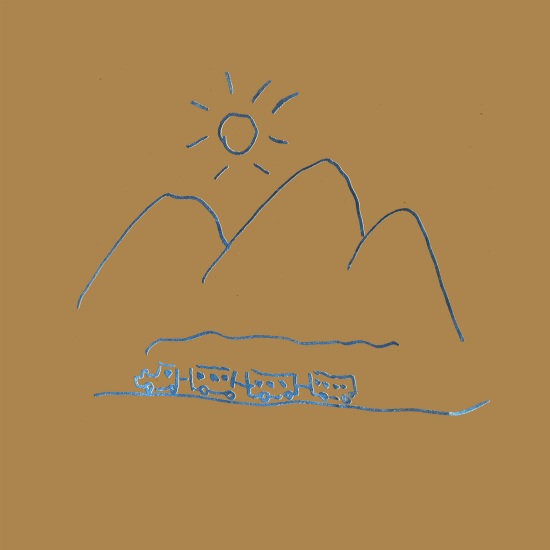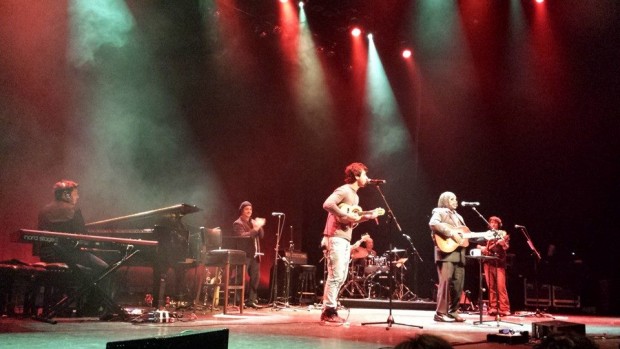By: Holly Holmes
2013 has been one of celebration for Milton Nascimento. Besides celebrating his 71st birthday on 26 October, Milton has been commemorating his 50-year career as a musician that began with the EP Barulho de Trem recorded in Belo Horizonte in 1963. If the London installment of Milton’s tour 50 Anos de Carreira—Uma Travessia [50-Year Career—A Traverse] is any indication of his vibrancy, then I expect to see many more commemorations to come.
After a captivating performance by the performer-composer Siba from Pernambuco state in northeastern Brazil, the audience murmured with anticipation while the crew changed the stage to receive Milton Nascimento and his band. Much of this buzz was in Portuguese—in the lobby, in the ladies’ bathroom, and from my own friend from Lisbon who joined me for the concert. A mug sat prominently on a stool next to Milton’s microphone showing his own drawing of the mountains from his own state Minas Gerais that also adorns the cover of the album Geraes.

Album cover from Milton Nascimento’s 1976 release Geraes, featuring his artistic rendering of the mountainous landscape of Minas Gerais state.
Milton entered the Barbican auditorium to enthusiastic applause, and the slow pace of his ginger footsteps gave him all the more time to soak it up. As a commemorative show, the repertoire drew largely from Milton’s best-known albums of the 1970s (see full set list below). The group kicked off the evening with the rousing anthem to liberty and optimism “Credo [Creed].” Though it is a song that few would name as a favorite (through no defect of its own), it sums up Milton’s ability to compose veiled protest song that functions equally well as a timeless rock anthem about the hope invested in Brazilian youth:
“Caminhando pela noite de nossa cidade
Walking through the night of our city
Acendendo a esperança e apagando a escuridão
Lighting hope and putting out the darkness
Vamos! Caminhando pelas ruas de nossa cidade
Let’s go! Walking through the streets of our city
Viver derramando a juventude pelos corações
To live pouring the youth through our hearts
Tenha fé no nosso povo que ele resiste
Have faith in our people that they resist
Tenha fé no nosso povo que ele insiste
Have faith in our people that they insist
E acorda novo, forte, alegre, cheio de paixão
And awake new, strong, happy, full of passion.”
Many shouted along with the band’s punctuated accompaniment to the word, “Vamos! [Let’s go!]” It struck me that such socially conscious song is as relevant in today’s democratic Brazil, rife with political dissatisfaction and social protest, as it was in the dictatorial Brazil of the 1970s.
Guitarist and musical director Wilson Lopes, Milton’s constant companion since first working together on Angelus in 1993, provided sensitive accompaniment on “Cais [Quay]’, one of Milton’s best-loved songs. Fans and journalists alike have recently criticized Milton for not using as much falsetto as he once did or for the occasional out-of-tune notes at the extremes of his range, but I feel that these critics are missing the point. Milton’s voice is still quite strong and rich, and it is the conviction with which he sings that is most beautiful: “Eu quero mais! [I want more!]” For the famous closing theme, pianist Kiko Continentino left his perch allowing Milton to take over the grand piano. Drummer Lincoln Cheib—a joyful performer and attentive collaborator—helped build anticipation first with the toms, then with the full drum set until the group reached a bombastic peak.
Kiko’s lush piano accompaniment segued directly into “Vera Cruz.” First recorded on the album Courage in 1968, the session was held at the legendary Van Gelder Studios in New Jersey alongside jazz legend Herbie Hancock and Brazilian arranger and organist Eumir Deodato. As a young jazz singer in Michigan, this was the first song I ever heard by Milton Nascimento. For my generation of jazz musicians, it has remained a fervent favorite, and it is no wonder why, after witnessing the exuberant solos by saxophonist Widor Santiago and each of the band members in their turn.
Another strong theme in Milton’s music is that of fraternity and friendship. The medley of the songs “Clube da Esquina” and “Clube da Esquina No. 2” by Milton and Lô Borges celebrated his lifelong friendships with the collective of musicians that became known by the name Clube da Esquina [Corner Club]. The latter song became perhaps most poignant as Wilson and bassist Gastão Villeroy contributed backing vocals for the first time, while Milton performed lyrics that play with the sound of repeated words. Speaking at first about childhood friendships, then adult friendships, the lyrics eventually expand to include the universal friend, that is, Milton’s fans from all over the world: “Quero ver então a gente, gente, gente, gente, gente … [So I want to see the people, people, people, people, people].” Raising his arms in offering to the crowd, ecstatic cheers from the audience confirmed that the sentiment was reciprocated.

Milton Nascimento e Banda at the Barbican, 20 October 2013: Pictured from left Kiko Continentino (piano, keyboards), Widor Santiago (saxophones), Pedro Nascimento (vocals, cavaquinho), Gastão Villeroy – obscured (electric bass), Lincoln Cheib (drums, percussion), Milton Nascimento (vocals, guitar), Wilson Lopes (musical director, guitar). Photo by Matthew Warnock
The rest of the show was peppered with crowd pleasers, favorites for the connoisseur, and an obscure gem. Milton’s gypsy samba in ¾ time “Cravo e Canela [Clove and Cinnamon]” got the crowd to groove and sing, but the band also showed appealing versatility by ending with a stripped-down, bluesy and gritty version at half tempo. Another crowd favorite came in the form of the psychedelic rock song “Fé Cega, Faca Amolada [Blind Faith, Sharp Knife],” a song rarely played by Milton in live shows. Faltering slightly on the falsetto melody, the song once helped launch the career of fellow performer-composer Beto Guedes when they shared lead vocals on its 1975 recording.
For the connoisseur, Milton played a lovely instrumental medley in dedication to his mother Lília. Adopted at an early age by Josino and Lília de Brito Campos, Milton described her influence on him as inestimable: “You can look for … [his English falters] poesia … o que é que é poesia? [he asks the audience what is it that is poetry? someone answers] … poetry, books, the world. Never you gonna find something as beautiful as my mother. She is the goddess that made me a musician, a person, everything.” The wordless theme “Lília” is perhaps not what one might expect of a doting son. Rather than a sentimental ballad, we hear something more akin to film music—perhaps cowboys crossing the vastness of the sertão [Brazilian hinterlands] at a punishing pace.
“Lília” moved seamlessly into a wordless version of “Maria Três Filhos [Maria of Three Children],” and the playfulness of the band was in full force. Used as a vehicle for improvisation, each member played cleverly with the theme, that can be divided simultaneously into either 4 beats or 5 beats, including a particularly satisfying exchange between drummer Lincoln Cheib and Milton’s percussive guitar chords. In an ongoing tribute to family and fraternity, Milton introduced his own adopted son to sing and play cavaquinho—a 4-string instrument similar to the ukulele used commonly in samba and choro styles—on “Circo Marimbondo.”
As for the rare gem, Milton sang his Portuguese version of “Amor e Paixão,” a song he performed and recorded with the jazz singer Sarah Vaughan as “Love and Passion” in 1987. He has never recorded the song as a soloist, but remarked that he still intends to do so. Milton did not leave his most dedicated fans in the lurch for popular hits. He handled the vociferous fans with grace as many shouted out requests throughout the night, while others insisted, “Deixa ele cantar o que quer! [Let him sing what he wants!].” Each hit was cheered as he sang “Para Lennon e McCartney [For Lennon and McCartney],” “Maria, Maria,” and closed the show with the song that started his career “Travessia [Journey].”
The real demonstration of the fandom present at the Barbican came when he asked the audience to sing to him. He has been making this request of audiences for the past few years, and London did not disappoint. If somewhat bashfully, one could hear “Canção da América [Song of America]” from beginning to end. Though composed in Los Angeles, for many the song is an homage to Brazilian friendship (the first line sings, “Amigo é coisa pra se guardar debaixo de sete chaves [A friend is something to be kept under seven locks and keys]”), for others an analogy for shared struggle and oppression throughout Latin America. Perhaps in the Barbican, the best metaphor was one of a friendship that can dissolve the constructs of nation, borders, and cultural difference. Surely, one thing Milton best demonstrates is the power of music to unite and delight.
Author’s Note: Milton Nascimento recently donated thousands of items from his personal archives to be shown on digital display at the Jobim Institute in Rio de Janeiro. Music fans can stream many of his albums for free: http://www.jobim.org/milton. Follow the link to the website, click on Audio and Video, then scroll down to the album covers and choose from more than 30 recordings released throughout Milton’s long career.
1. Credo (Milton Nascimento / Fernando Brant; Clube da Esquina 2 1978)
2. Cais (Milton Nascimento / Ronaldo Bastos; Clube da Esquina 1972)
3. Vera Cruz (Milton Nascimento / Márcio Borges; Courage 1968, Angelus 1993)
4. Clube da Esquina (Milton Nascimento / Lô Borges / Márcio Borges; Milton 1970)
5. Clube da Esquina No. 2 (Milton Nascimento / Lô Borges / Márcio Borges; Clube da Esquina 1972)
6. Cravo e Canela (Milton Nascimento / Ronaldo Bastos; Clube da Esquina 1972)
7. Amor e Paixão (Milton Nascimento; Recorded as “Love and Passion” on Sarah Vaughan’s Brazilian Romance 1987)
8. Lília (Milton Nascimento; Clube da Esquina 1972)
9. Maria Três Filhos (Milton Nascimento / Fernando Brant; Milton 1970)
10. Circo Marimbondo (Milton Nascimento e Ronaldo Bastos; Geraes 1976)
11. Ponta de Areia (Milton Nascimento / Fernando Brant; Minas 1975)
12. Saídas e Bandeiras (Milton Nascimento / Fernando Brant; Clube da Esquina 1972)
13. Canção da América (Milton Nascimento / Fernando Brant; Sentinela 1980)
14. Fé Cega, Faca Amolada (Milton Nascimento / Ronaldo Bastos; Minas 1975)
15. Para Lennon e McCartney (Lô Borges / Márcio Borges / Fernando Brant; Milton 1970)
16. Maria, Maria (Milton Nascimento / Fernando Brant; Clube da Esquina 2 1978)
17. Raça (Milton Nascimento / Fernando Brant; Milton 1976)
18. Travessia (Milton Nascimento / Fernando Brant; Travessia 1976)
Review in Guitar International: Milton Nascimento at the Barbican | HollyHolmes.com (10 years ago)
[…] As published in Guitar International, 2 December 2013. […]